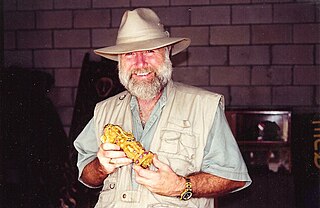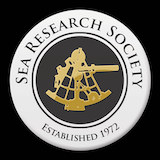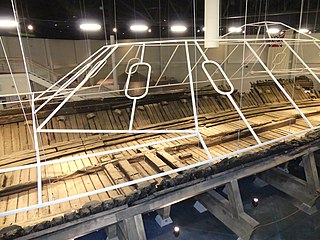
Maritime archaeology is a discipline within archaeology as a whole that specifically studies human interaction with the sea, lakes and rivers through the study of associated physical remains, be they vessels, shore-side facilities, port-related structures, cargoes, human remains and submerged landscapes. A specialty within maritime archaeology is nautical archaeology, which studies ship construction and use.

Underwater archaeology is archaeology practiced underwater. As with all other branches of archaeology, it evolved from its roots in pre-history and in the classical era to include sites from the historical and industrial eras.

USS Housatonic was a screw sloop-of-war of the United States Navy, gaining its namesake from the Housatonic River of New England.

H. L. Hunley, also known as the Hunley, CSS H. L. Hunley, or CSS Hunley, was a submarine of the Confederate States of America that played a small part in the American Civil War. Hunley demonstrated the advantages and dangers of undersea warfare. She was the first combat submarine to sink a warship (USS Housatonic), although Hunley was not completely submerged and, following her attack, was lost along with her crew before she could return to base. Twenty-one crewmen died in the three sinkings of Hunley during her short career. She was named for her inventor, Horace Lawson Hunley, shortly after she was taken into government service under the control of the Confederate States Army at Charleston, South Carolina.

The first USS Yorktown was a 16-gun sloop-of-war of the United States Navy. Used mostly for patrolling in the Pacific and anti-slave trade duties in African waters, the vessel was wrecked off Maio, Cape Verde in 1850.
The National Underwater and Marine Agency (NUMA) is a private non-profit organization in the United States founded in 1979. Originally it was a fictional US government organization in the novels of author Clive Cussler. Cussler later created and, until his death in 2020, led the actual organization which is dedicated to "preserving our maritime heritage through the discovery, archaeological survey and conservation of shipwreck artifacts.” Additionally "NUMA does not actively seek private funding. Most of the financial support for the projects comes from the royalties from Clive Cussler’s books."

The Naval History and Heritage Command, formerly the Naval Historical Center, is an Echelon II command responsible for the preservation, analysis, and dissemination of U.S. naval history and heritage located at the historic Washington Navy Yard. The NHHC is composed of 42 facilities in 13 geographic locations including the Navy Department Library, 10 museums and 1 heritage center, USS Constitution repair facility and detachment, and historic ship ex-USS Nautilus.

A spar torpedo is a weapon consisting of a bomb placed at the end of a long pole, or spar, and attached to a boat. The weapon is used by running the end of the spar into the enemy ship. Spar torpedoes were often equipped with a barbed spear at the end, so it would stick to wooden hulls. A fuse could then be used to detonate it.

CSS Georgia, also known as State of Georgia and Ladies' Ram, was an ironclad warship built in Savannah, Georgia in 1862 during the American Civil War. The Ladies' Gunboat Association raised $115,000 for her construction to defend the port city of Savannah.
Aviation archaeology is a recognized sub-discipline within archaeology and underwater archaeology as a whole. It is an activity practiced by both enthusiasts and academics in pursuit of finding, documenting, recovering, and preserving sites important in aviation history. For the most part, these sites are aircraft wrecks and crash sites, but also include structures and facilities related to aviation. It is also known in some circles and depending on the perspective of those involved as aircraft archaeology or aerospace archaeology and has also been described variously as crash hunting, underwater aircraft recovery, wreck chasing, or wreckology.

Treasure hunting is the physical search for treasure. For example, treasure hunters try to find sunken shipwrecks and retrieve artifacts with market value. This industry is generally fueled by the market for antiquities.

The archaeology of shipwrecks is the field of archaeology specialized most commonly in the study and exploration of shipwrecks. Its techniques combine those of archaeology with those of diving to become Underwater archaeology. However, shipwrecks are discovered on what have become terrestrial sites.

Edward Lee Spence is a pioneer in underwater archaeology who studies shipwrecks and sunken treasure. He is also a published editor and author of non-fiction reference books; a magazine editor, and magazine publisher ; and a published photographer. Spence was twelve years old when he found his first five shipwrecks.

The Sea Research Society (SRS) is a non-profit organization promoting research and education in marine science and history. Founded in 1972 by underwater archaeologist E. Lee Spence, SRS undertakes archival research and underwater expeditions in search of historic shipwrecks. From 1972 to 1978, it also operated the College of Marine Arts.
The Convention on the Protection of the Underwater Cultural Heritage is a treaty that was adopted on 2 November 2001 by the General Conference of the United Nations Educational, Scientific and Cultural Organization (UNESCO). The convention is intended to protect "all traces of human existence having a cultural, historical or archaeological character" which have been under water for over 100 years. This extends to the protection of shipwrecks, sunken cities, prehistoric art work, treasures that may be looted, sacrificial and burial sites, and old ports that cover the oceans' floors. The preservation of underwater cultural heritage is significant as it allows for the retelling of numerous historical events. As part of its duty to conduct scientific research and provide continuous education on the importance of underwater cultural heritage, UNESCO strives to maintain these sites for the enjoyment of current and future generations. The convention may provide a customary framework to help raise awareness and seek to combat the illegal looting and pirating occurring in waters worldwide. As an international body, member states of the convention agree to work towards the preservation of sunken cultural property within their jurisdiction and the high seas.
Mark M. Newell, Ph.D. RPA is a British/American underwater and terrestrial archaeologist and anthropologist, the director of the Georgia Archaeological Institute. He received his doctorate from St. Andrews University, Scotland. Newell began diving in Bermuda in 1963. While working as a journalist, he continued to dive throughout the Caribbean and South America, developing an interest in the archaeological potential of the sites he discovered. In 1996 he completed a Ph.D. in underwater archaeology at the Scottish Institute of Maritime Studies at the University of St. Andrews.

CSS Neuse was a steam-powered ironclad ram of the Confederate States Navy that served in the latter part the American Civil War and was eventually scuttled in the Neuse River to avoid capture by rapidly advancing Union Army forces. In the early 1960s, she produced approximately 15,000 artifacts from her raised lower hull, the largest number ever found on a recovered Confederate vessel. The remains of her lower hull and a selection of her artifacts are on exhibit in Kinston, North Carolina at the CSS Museum, which belongs to the North Carolina Department of Natural and Cultural Resources. The ironclad is listed on the National Register of Historic Places.

The Sinking of USS Housatonic on 17 February 1864 during the American Civil War was an important turning point in naval warfare. The Confederate States Navy submarine, H.L. Hunley made her first and only attack on a Union Navy warship when she staged a clandestine night attack on USS Housatonic in Charleston harbor. H.L. Hunley approached just under the surface, avoiding detection until the last moments, then embedded and remotely detonated a spar torpedo that rapidly sank the 1,240 long tons (1,260 t) sloop-of-war with the loss of five Union sailors. H.L. Hunley became renowned as the first submarine to successfully sink an enemy vessel in combat, and was the direct progenitor of what would eventually become international submarine warfare, although the victory was Pyrrhic and short-lived, since the submarine did not survive the attack and was lost with all eight Confederate crewmen.

The conservation-restoration of the H.L. Hunley is currently being undertaken by the Warren Lasch Conservation Center; they hope to have the Hunley project completed by 2020. Since the Hunley was located in 1970 by Dr. E. Lee Spence and recovered from the ocean in 2000, a team of conservators from the Lasch Conservation Center has been working to restore the Hunley.

USS YOG-42 was a gasoline barge built by Concrete Ship Constructors, in National City, California. She was launched on March 23, 1943. Acquired by the United States Navy on May 23, 1943. She was assigned to the Asiatic-Pacific Theater, and survived the war. Re-designated YOGN-42 in May 1946, she was struck from the Naval Register on August 15, 1949. Sometime the next year, she was intentionally beached on the north coast of Lānaʻi in the Hawaiian Islands.




















